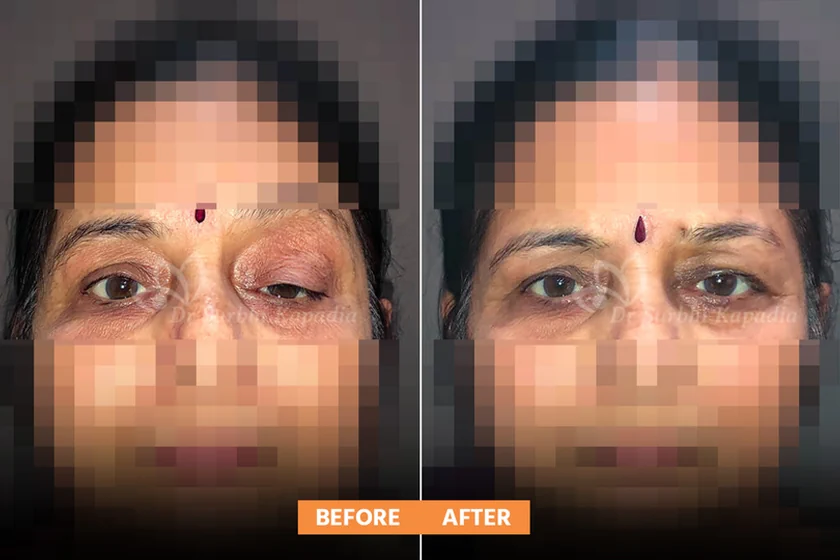
What is Ptosis?
Ptosis, often referred to as ‘droopy eyelid,’ is a condition where the upper eyelid tends to sag or drop. It may affect one or both eyelids and can give you a tired or sleepy appearance. It is the medical term used for droopy eyelids. Ptosis (pronounced “toe-sis“) is a condition in which there is drooping of the upper eyelid. This should not be confused with extra skin or fat in the eyelid, which are typically addressed with blepharoplasty surgery. Ptosis is a condition due to the malfunctioning of the levator palpebrae superioris (LPS surgery) muscle, which is responsible for raising the upper eyelid.
In simple terms, imagine a curtain (your eyelid) and the string used to pull it up (levator palpebrae superioris muscle). When the string doesn’t work correctly, the curtain doesn’t pull up properly – that’s exactly what happens in ptosis. The muscle responsible for lifting the eyelid doesn’t function as it should, causing the eyelid to droop.
This is not the same as having extra skin or fat around your eyelid, which is a different condition that can be fixed with a different type of surgery called blepharoplasty. Ptosis can be present from birth (congenital ptosis) or develop due to ageing, an injury, or a neurological condition.
Regardless of the reason, it is important to address ptosis because, in severe cases, the drooping eyelid can obstruct vision. Additionally, it might make you feel self-conscious about your appearance. However, treatments are available, including safe surgical procedures, to correct this condition and restore a more open, alert appearance to the eyes.
Causes of Ptosis
Ptosis can be attributed to a range of factors including:
Congenital Ptosis:
This form of ptosis is present from birth, often noticeable through uneven eyelid creases.
Idiopathic:
The cause is unknown in these cases.
Post-Traumatic:
Ptosis can result from an injury or damage to the nerve controlling the eyelid muscles.
Neurological Issues:
Certain conditions such as Myasthenia Gravis can lead to ptosis.
Tumours:
Tumors that damage nerves can lead to ptosis.
Symptoms of Ptosis
The primary symptom of ptosis is a visible drooping of the upper eyelid, often resulting in an aesthetic discrepancy between the eyelids or a “sleepy look.” In the case of congenital ptosis, uneven eyelid creases are common. Children with ptosis often display certain gestures like frequent eyebrow raising and head tilting, indicative of the condition. If the droopiness interferes with vision, it can lead to lazy eye (amblyopia) or astigmatism.
Ptosis Treatment in Vadodara
In Vadodara, ptosis correction is performed through a minor surgical procedure, aimed at tightening the muscle that lifts the eyelid. This can be executed either through the eyelid skin or from the eyelid’s inside, depending on the pre-operative evaluation’s specific findings.
Indications for Treatment
Consideration for ptosis treatment is based on several factors including cosmetic concern, the severity of ptosis, head tilt, the child’s age, involvement of one or both eyelids, eyelid height, the strength of the eyelid muscle, and eye movements.
Surgical Procedure
The surgical method may involve tightening the eyelid muscle or removing a part of the lax eyelid muscle to achieve eyelid symmetry. When the eyelid muscle is underdeveloped, a frontalis sling or suspension procedure is conducted to connect the eyelid directly to the frontalis muscle, ensuring the efficient transmission of brow movement to the eyelid.
Post-Operative Care
In children, ptosis often arises from birth due to underdeveloped levator muscles. After surgery, patients should avoid rubbing or washing their eyes for the first week. Regular check-ups with the ophthalmic plastic surgeon are also encouraged as minor adjustments may occasionally be required.
Appointment for Ptosis Treatment
For any queries or to know more about our services, feel free to drop an email at drsurbhikapadia@gmail.com. We are more than happy to assist you. Alternatively, you can fill out the enquiry form, and we will get back to you at the earliest:
| Appointments | Address |
|---|---|
| Monday — Friday | Aadicura Superspeciality Hospital, |
| 09:00 am - 05:00 pm | Jetalpur Road, Vadodara - 390020, |
| Phone: 8980 50 00 15 | Gujarat, India |
Other Locations:
Aadicura Superspeciality Hospital, Godhra
Frequently Asked Questions About Ptosis
You should avoid rubbing or washing your eyes for the first week after surgery. A regular check-up with your ophthalmic plastic surgeon is recommended, as minor readjustments may be occasionally needed.
Most patients experience long-lasting results when the surgery is performed by expert ophthalmic plastic surgeons. However, in cases of delayed surgery, longstanding Ptosis, or poor muscle tone, recurrence may happen.
Yes, you can eat after Ptosis surgery. Except for children, the surgery is performed under local anaesthesia.
While there are different grades of Ptosis and various surgical methods to treat it, most surgeries are straightforward when performed by trained and qualified ophthalmic plastic surgeons.
Yes, there are specific indications for treating Ptosis in children. In fact, timely treatment is crucial as untreated Ptosis can lead to vision problems in children.
After surgery, avoid rubbing or washing your eyes for the first week, and keep the surgical area clean. Do not engage in strenuous activities and follow the specific aftercare instructions provided by your surgeon.
As with any surgery, there are potential risks, including infection, bleeding, scarring, or asymmetry. Rarely, there may be a complication affecting the eye muscles, leading to double vision.
Most patients see long-lasting results from Ptosis surgery. However, in some cases, especially when the Ptosis is severe or the muscle tone is poor, a secondary surgery may be required.
Problems can include surgical complications, dissatisfaction with cosmetic results, and potentially the need for further surgery.
For many patients, especially those experiencing vision obstruction or significant cosmetic concerns, Ptosis surgery can greatly improve their quality of life, making the procedure worthwhile.
Ptosis surgery is typically performed under local anaesthesia, so the procedure itself is not painful. Post-operative discomfort can usually be managed with over-the-counter pain medication.
Yes, Ptosis surgery is generally successful in correcting droopy eyelids and improving the patient’s vision and appearance. The success rate varies depending on the patient’s specific condition and the surgeon’s experience.
General Oculoplasty
Ophthalmic Plastics
- Entropion / Ectropion
- Ptosis
- Thyroid Eye Disease
- Dacryocystitis
- Painful Blind Eye & Artificial Eye
- Stye (Chalazion)
Orbit and Ocular Oncology
Trauma
Aesthetic Oculoplasty
Non-surgical Cosmetic Procedures
Surgical Cosmetic Procedures


